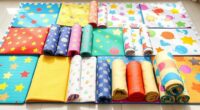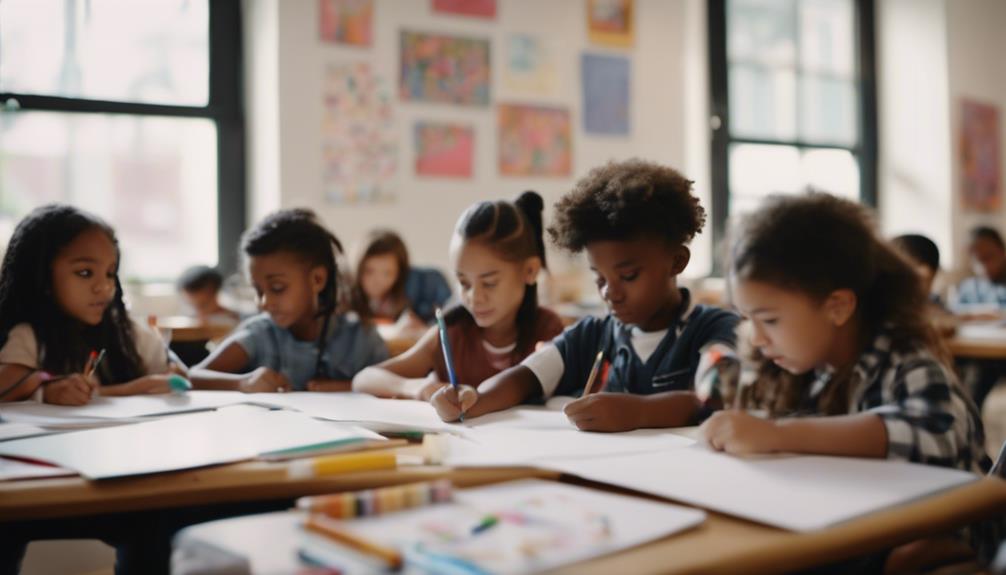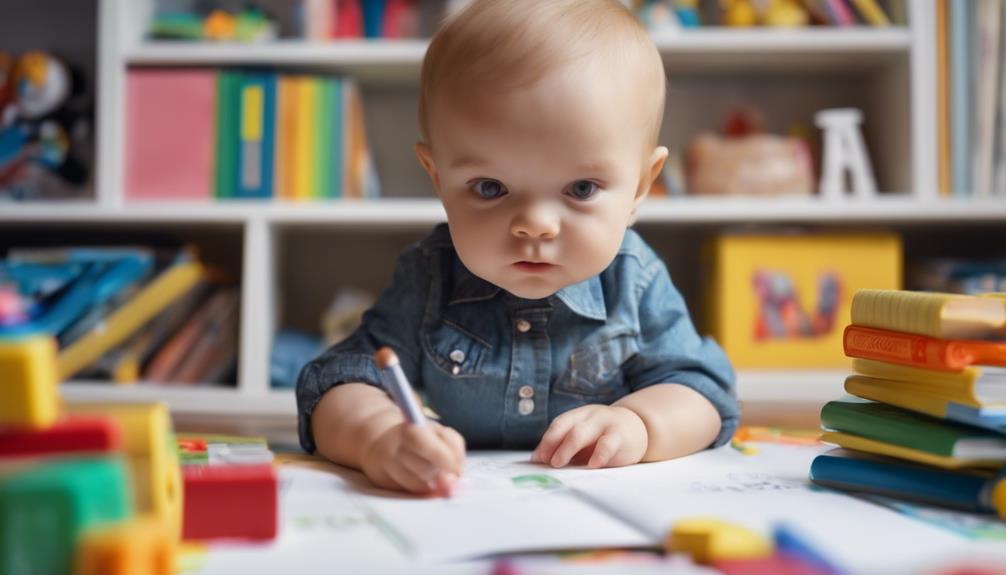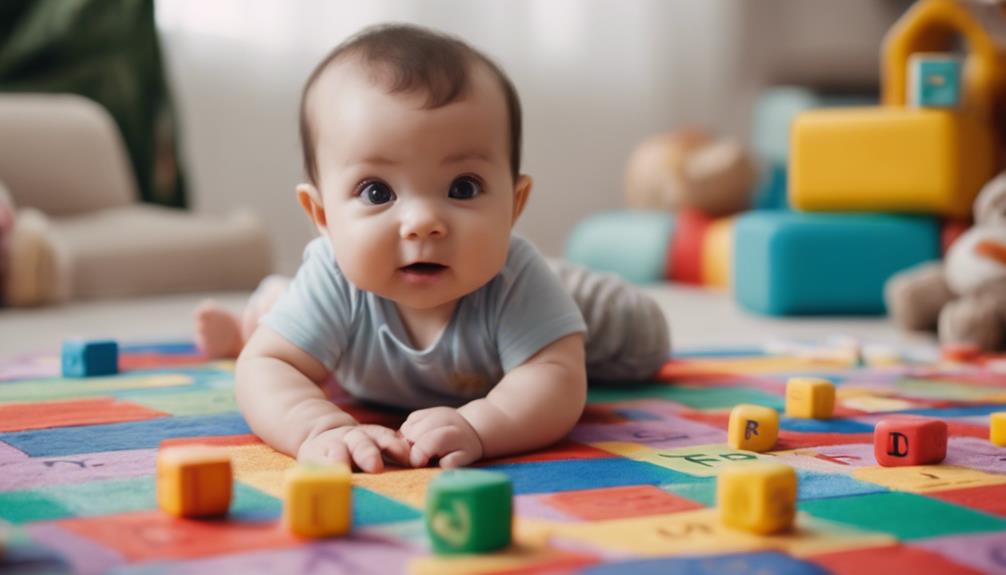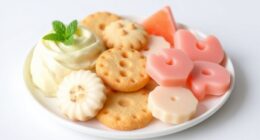To create a safe, stimulating DIY baby gym, choose non-toxic, colorful materials and add textured, crinkly, and shiny toys that engage your infant’s senses. Secure everything firmly and guarantee the frame is stable with non-slip pads. Hang toys at various heights to encourage reaching and exploration. Regularly inspect for wear and keep it clutter-free. If you keep exploring, you’ll discover more tips to make a fun, safe activity center for your little one.
Key Takeaways
- Use safe, non-toxic materials and secure attachments to create colorful, textured toys that stimulate infants’ senses.
- Design the gym at appropriate height with varied hanging toys to promote reaching and motor development.
- Incorporate soft fabrics, crinkly textures, and mirrors to enhance tactile and visual stimulation.
- Ensure the structure is stable, with non-slip pads and no sharp edges, for safe independent exploration.
- Regularly inspect and maintain the gym, replacing worn or damaged parts and supervising infants during use.

Creating a DIY baby gym is a fun and cost-effective way to stimulate your little one’s development at home. When designing your homemade activity center, focusing on sensory development is key. Babies learn best through their senses, so incorporating a variety of textures, colors, and sounds can enhance their experience. Think about attaching soft fabric toys, crinkly materials, or shiny, colorful objects to the gym’s frame. These elements encourage your baby to reach, grasp, and explore, fostering their fine motor skills and curiosity. You can also include mirrors or textured panels to engage their sense of sight and touch. The goal is to create a rich sensory environment that invites exploration and supports their growing awareness of the world around them.
However, safety considerations should always be at the forefront of your DIY project. Before assembling anything, ensure that all materials are non-toxic and free of small parts that could pose a choking hazard. Use sturdy, reliable hardware to secure toys and attachments, making sure nothing can easily fall or come loose during play. Check that the frame is stable and won’t tip over easily—adding non-slip pads to the base can help keep it steady. Keep the overall structure at a height that allows your baby to reach comfortably without overextending or straining. Avoid sharp edges, rough fabrics, or loose strings that might cause injury or discomfort. Remember, the primary purpose of a baby gym is to promote safe, supervised play while stimulating their senses.
When selecting materials and designing your DIY baby gym, consider the space where it will be used. If you’re working in a smaller area, opt for a compact design that doesn’t clutter the room. If you want more variety in sensory input, hang different textured or colorful toys at varying heights to encourage movement and reaching. Regularly inspect the gym for wear and tear, replacing any damaged toys or parts immediately. Supervise your baby during playtime, and never leave them unattended with the gym, especially when new toys or attachments are introduced. With thoughtful planning and attention to safety, your homemade baby gym can become a stimulating, safe space that nurtures your infant’s sensory development and encourages independent exploration.
Frequently Asked Questions
What Safety Standards Should I Follow for Homemade Baby Gyms?
When making a homemade baby gym, you should follow safety standards like ensuring sturdy construction to prevent collapse or injury. Use non-toxic finishes on all materials to keep your baby safe from harmful chemicals. Check that all parts are smooth, rounded, and free of sharp edges or small pieces that could pose choking hazards. Regularly inspect the gym for wear and tear, and always supervise your baby during play for added safety.
How Can I Ensure the Materials Are Non-Toxic and Baby-Safe?
Think of creating a safe space for your baby like building a fortress—they need strong, non-toxic materials. To guarantee your homemade gym is baby-safe, choose non-toxic paints and baby-safe fabrics, avoiding harmful chemicals. Always verify labels and opt for organic or certified safe options. I once used non-toxic spray paint for a craft project, and knowing it was safe for my child gave me peace of mind—just like your infant’s safety.
What Age Is Best Suited for a DIY Baby Gym?
You should start using a DIY baby gym when your baby reaches about 2 to 4 months old, as they begin to develop their visual and motor skills. This age is ideal for supporting developmental milestones and providing sensory stimulation. During this period, your baby is more alert and curious, making a homemade activity center an effective way to encourage exploration and strengthen their coordination and sensory awareness.
How Do I Clean and Maintain a Homemade Activity Center?
To keep your homemade activity center safe and clean, establish regular cleaning routines using gentle, non-toxic cleaners suitable for the materials you’ve used. Focus on wiping down surfaces and toys daily, especially after use. Consider the material durability—wood might need occasional sanding or sealing, while fabric parts should be washed or spot-cleaned. This routine guarantees the activity center stays hygienic and safe for your baby’s playtime.
Are There Any Common Mistakes to Avoid When Building a DIY Baby Gym?
When building a DIY baby gym, you might focus on fun details but overlook key mistakes. Avoid rushing, which can compromise material selection and structural stability. Don’t underestimate the importance of sturdy, non-toxic materials and secure joints. Skimping on these details risks safety and durability. Balance creativity with careful planning to ensure your activity center is both engaging and stable, giving your baby a safe, enjoyable space to play and explore.
Conclusion
Creating a DIY baby gym lets you craft a personalized space for your little one’s growth, blending creativity with practicality. It’s a simple act of building something special—yet it’s also an investment in your baby’s development. As you assemble colorful toys and soft fabrics, remember that this handmade oasis is both a fleeting moment of your effort and a lasting foundation for their curiosity. In the end, your touch turns everyday objects into lifelong memories.


